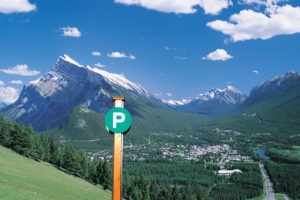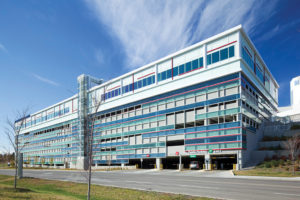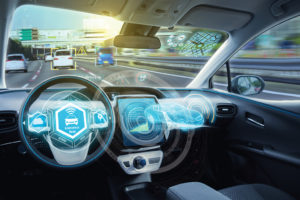An interview with Shawn Skrine
By gtechna
In advance of this year’s Canadian Parking Association Conference held in Banff, Alberta, Banff’s Shawn Skrine sat down with gtechna, a Montreal-based eCitation and parking software company, for an interview that revealed some interesting points about what exactly makes a city “smart”.
Banff is a resort town located inside a national park, which means it has a small number of permanent residents and a seasonal population that fluctuates widely. Embracing cutting-edge parking technology has allowed Banff to easily accommodate the annual influx of tourist traffic; a great reminder that being a smart city is more about innovation than population!
Can you describe for us what parking is like in Banff?
We have five full time enforcement officers and in the summer, two to three seasonal officers. Our officers use two vehicles and two bikes to patrol roughly 2,000 spaces that we have downtown.
We have several surface lots, one four-story parking structure, and a good deal of street parking. All of our parking is time-limited, but free.
How does Banff’s high volume of tourists affect the parking situation?
To be honest with you, it’s more of the locals that were affected when we started implementing time-limit parking than it was the tourists, because tourists seem to look for signs.
We started time-limiting the parking to change behavior, which seems to have happened. Now after three years, there’s been about a 30% increase in time-limit compliance. The number of tickets issued for time-limit offences has been reduced and downtown parking turnover has improved, which is what we wanted.
What are the rules you use for time-limited parking?
It varies. Our zones range from 15-minute limits all the way to nine-hour limits. Streets usually have either two-hour or 15-minute limits, parking lots are all three hours, the parking structure has two-hour and eight-hour spaces, and there are…
By Danielle Desjardins
Thanks to the advancement of mobile computing, embattled city drivers cruising for a parking spot in our cities asphalt jungles are being presented with numerous new tools.
These tools come from a new wave of start-ups catering to parking services. These apps can book parking spaces before the driver leaves, pay for it online and even, in some instances, locate available parking spaces.
Take Parkifi, for instance. The Denver company has put together a mix of way-finding, data analytics and Internet of Things (IoT) technologies that uses hardware embedded in parking spots to alert drivers to open parking spaces (the feature is only available in Denver for now).1 Last spring the app added a way for users to pay for parking from their phone2.
Parkifi (https://www.parkifi.com/) presents itself to parking operators as an optimizer of their portfolios through a better exploitation of inventory utilization, prediction of future occupancy, optimization of pricing to match supply and demand, among other things.
What they offer parking operators is “efficient visibility and marketing tool by providing a better “parking experience for drivers, increasing satisfaction and repeat business”.
Or, as Parkman, another parking tools developer based in Finland, puts it: “customers are using phones to navigate to destinations. Make sure they navigate to your garage.”3
Finding available parking spaces in real-time is no magic act. For Parkopedia, a nine-year-old London company, it involves big data. The company relies on a trove of parking data it amassed since being established in 2007: starting with humans doing the job of surveying and taking pictures of parking garages, evolving to dynamic data sets provided via APIs from partners to GPS and traffic flow information from car manufacturers, accumulating along the way petabytes of parking information in the cloud. With this information, the predictive algorithms the Parkopedia team of four PhDs developed…
By Chelsea Webster
Let’s start the first mile of this journey by setting a goal for reading this article: learning what first mile and last mile means in relation to transportation, and finding ways for the parking industry to embrace (and maybe even capitalize) on this growing urban challenge.
The Rise of Public Transit
If you live in a city, you likely understand that public transit is an important part of city life. As more of the world’s population moves into cities, and cities aren’t able to accommodate the demand for individual cars and parking, transit will continue to grow in importance. There are lots of articles already touting that the personal vehicle is falling as king of transportation. As this process happens, it will be even more critical to make taking alternate methods of transportation as easy as possible.
If you’ve ever tried to take public transportation, you’re likely aware of a big setback inherent in any transit system: it doesn’t come right to your door.
So, if people aren’t willing to walk to the “nearest” transit stop, but still want to take the train or subway or express bus, how do they get to that transit stop? The process is called first mile (getting from your house or starting point to the transit stop) and last mile (getting from where transit lets you off to your actual destination) commuting.
We Love Our Cars
Thanks to the automobile revolution, we’ve seen the personal vehicle have a massive economic impact. Highways were built, automotive factories churned out vehicles of all sorts, and a whole new parking industry sprang up – all of which created hundreds of thousands of jobs in Canada and the US. With the ability for the average person to own a vehicle, people had the freedom to live and travel to places previously…
By Chris Davis, BSc, P.Eng., CEng, MICE, MIStructE, LEED® AP | Principal, RJC Engineers
The right parking plan is critical to the success of a parkade project – it strongly influences the budget and ultimately, the long term success for the owner. Determining an optimal plan requires careful, thoughtful design with experience and expertise in parking planning, but it also requires a fundamental understanding of how structural systems are integrated. The ideal solution provides a highly functional layout within an economical and easily constructed building.
No two buildings are ever the same. In order to meet the vast range of challenges that are presented throughout any given project, parking structure designers need to understand the objectives of their clients and the demands of the industry before beginning the design of a building. If they fully understand what the requirements and priorities are, they are better equipped to develop an optimal solution that can perform a range of functions – taking into account current and future uses.
Our industry is facing the impending probability that the presence and use of motor vehicles will soon be seeing major changes. With these changes, we will see the inevitable reduced demand for parking structures as we know them today. The parking industry, understandably, is starting to reconsider how parkades should be constructed for the future, with design life to structural codes of a minimum of 50 years. It is unlikely that many of the parkades we build today will be used in the same way in 50 years’ time. So, how do we make these purpose-built, one-function structures suitable for future use, when it’s so difficult to predict what they will need to do?
TRADITIONAL PARKING DESIGNS
Parking planning involves the efficient layout of traffic flow (entries, exits, circulation, etc.) and stalls within a given footprint. Developing the…
By Danielle Desjardins
We are on the brink of a revolution, a revolution that will profoundly affect society, change the way cities look and function and fundamentally transform how people and goods move.
It’s been dubbed the “driverless revolution” and it will be brought about by the advent of autonomous cars (AV), cars that drive themselves with little or no human intervention. In addition to their effect on modes of transport, AVs are poised to disrupt many industries: fast food, real estate, hotels, airlines — large industries that will have to shift their strategies in the wake of driverless cars.
The biggest disruption could be on parking. Among other innovations the revolution will bring, we will see AV fleets moving continuously between the various places they are needed, rendering the need for close and convenient parking spaces much less necessary.
Ready for the driverless revolution?
In the last issue, we discussed the potentially impending driverless revolution and the impact it could have on the parking industry1. In the envisioned driverless society, fully automated vehicles (AVs) would drop their passengers at their destination, go home to park or return in the transportation network while awaiting their next ride and the parking industry would be massively disrupted.
To some, the driverless revolution is already be upon us and our roads will be overtaken by robocars within the next five to ten years. Is this belief shared by the people involved in parking and are they getting ready for it?
In need of a crystal ball
Although all those interviewed for this article believe AVs will eventually rule our roads, some also believe that the revolution will be a long time coming.
“I don’t see it happening in my lifetime”, states Professor Michel Lejeune, who teaches sociology of technology at École Polytechnique in Montréal. The technology may be outstanding and almost…








